Norovirus or Norwalk Virus
What is the Norovirus or Norwalk Virus?

It is estimated that nearly 65% of nonbacterial gastroenteritis in the US is attributable to Norwalk and Norwalk-like viruses. Approximately 181,000 cases occur annually, with no known associated deaths. Norwalk and Norwalk-like viruses have been associated with outbreaks on cruise ships and in communities, camps, schools, institutions and families. Foods such as raw oysters, cake frosting and salads, as well as drinking water, have been implicated as a common source of viral infection in several outbreaks.
Norwalk and Norwalk-like viruses also are referred to as "noroviruses." infection symptoms include nausea, vomiting, diarrhea and abdominal cramps. The incubation period is between 12 and 48 hours (average of 36 hours, with usual duration of 12-60 hours. Symptoms experienced less often include headache, fever, chills and myalgias. Fluid replacement is the common therapy.
Transmission of Norwalk virus is through the fecal-oral cycle. Although food is an efficient means of transmitting these agents, Norwalk and Norwalk-like viruses can be transmitted via water and by person-to-person contact. Transmission is of special concern for the fishing industry, since molluscan shellfish, being filter feeders, are readily contaminated with the stool-shed viruses present in human sewage.
More Information on Norovirus:
- Centers for Disease Control and Prevention - http://www.cdc.gov/ncidod/dvrd/revb/gastro/norovirus.htm
- Norwalk virus - Foodborne Pathogenic Microorganisms and Natural Toxins 1992 (Bad Bug Book)
Norwalk-like Viruses. Morbidity Mortality Weekly Reports (2001) -
Food Safety Project Director
Catherine H. Strohbehn, PhD, RD, CFSP
HRIM Extension Specialist
Adjunct Associate Professor
Hotel, Restaurant, and Institution Management
Iowa State University
Ames, Iowa, 50011-1121 USA
Email: cstrohbe@iastate.edu
Consumer and Processing Food Safety and ScienceSam Beattie, PhD
Food Safety Extension Specialist
Department of Food Science and Human Nutrition
Iowa State University Extension
122A MacKay Hall
Ames, Iowa, 50011-1121 USA
Email: beatties@iastate.edu
- Article History
- Revision Date: 8/16/2006



